|
|
|
Sort Order |
|
|
|
Items / Page
|
|
|
|
|
|
|
| Srl | Item |
| 1 |
ID:
124016
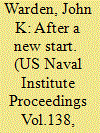

|
|
|
|
|
| Publication |
2012.
|
| Summary/Abstract |
While the United States has signed on to reduce its nuclear arsenal, the U.S. sea-based missile force remains crucial in a world where deterrence still matters.
|
|
|
|
|
|
|
|
|
|
|
|
|
|
|
|
| 2 |
ID:
158674
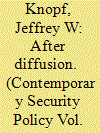

|
|
|
|
|
| Summary/Abstract |
This article discusses six challenges to enforcing norms regarding nuclear weapons. Three challenges reflect generic problems in international politics. These are differences in power, the collective action problem, and trade-offs with other interests. Three additional dilemmas reflect specific characteristics of the nuclear realm. First, membership in international treaties connected to the norms is not universal, raising questions about the appropriateness of enforcement against states that have not signed the treaties. Second, different implications of the norms can come into conflict with each other. In particular, there can be tensions between the requirements of nonproliferation and disarmament norms. Finally, some common options for norm enforcement become quite problematic when dealing with nuclear weapons. For example, if states respond to defections by starting their own nuclear weapons programs, this tit-for-tat response would defeat the purposes of the nonproliferation regime. Despite these challenges, nuclear norms enjoy widespread support and some enforcement is possible.
|
|
|
|
|
|
|
|
|
|
|
|
|
|
|
|
| 3 |
ID:
132781
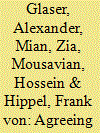

|
|
|
|
|
| Publication |
2014.
|
| Summary/Abstract |
Iran is negotiating with a group of six states over the future of its nuclear program. In November 2013, Iran and the P5+1 (China, France, Germany, Russia, the United Kingdom, and the United States) agreed to a Joint Plan of Action that seeks to reach a "comprehensive solution" by July 20, 2014.
The goal is an agreement on a set of measures that can provide reasonable assurance that Iran's nuclear program will be used only for peaceful purposes and enable the lifting of international sanctions imposed on Iran over the past decade because of proliferation concerns.
A key challenge is to reach agreement on limiting Iran's uranium-enrichment program, which is based on gas centrifuges, in a way that would enable Iran to meet what it sees as its future needs for low-enriched uranium (LEU) fuel for nuclear research and power reactors while forestalling the possibility that this program could be adapted to quickly produce highly enriched uranium at levels and in amounts suitable for use in nuclear weapons
|
|
|
|
|
|
|
|
|
|
|
|
|
|
|
|
| 4 |
ID:
183260
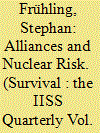

|
|
|
|
|
| Summary/Abstract |
There is a fundamental tension between the Biden administration’s stated intent to strengthen US alliances while at the same time reducing the role of US nuclear weapons. The credibility of extended-deterrence commitments – which in times of great-power conflict lie at the heart of US alliances – hinges on US allies and adversaries believing that Washington would resort to nuclear weapons to defend the core interests of its allies. A no-first-use or sole-purpose declaration would undermine deterrence and alliances by qualifying US security guarantees. The Biden administration and US allies should focus on coupling allied security to the threat of US nuclear use, to risks of inadvertent escalation for adversaries, and to the value of limited nuclear use in addressing conventional military imbalances in the Indo-Pacific. Forward-basing US nuclear forces in the region, where they are currently absent, is key to achieving all three of these aims.
|
|
|
|
|
|
|
|
|
|
|
|
|
|
|
|
| 5 |
ID:
089752
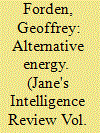

|
|
|
|
|
| Publication |
2009.
|
| Summary/Abstract |
President Mahmoud Ahmadinejad's retention of power means that Iran's nuclear ambitions are likely to continue. This article explores how and when Iran could achieve a nuclear weapons capability and what these scenarios might entail.
|
|
|
|
|
|
|
|
|
|
|
|
|
|
|
|
| 6 |
ID:
132808
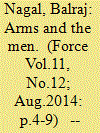

|
|
|
|
|
| Publication |
2014.
|
| Summary/Abstract |
The five pre-1998 nuclear powers have matured their Nuclear Command and Control Structures, and Nuclear Forces Structures (NFS) over a period ranging from 70 years for the US to 50 years for China.
The Cold War arms race created thousands of systems for command and control or functioning of military forces. The C4ISR systems deployed or under development provide 24 hours continuous surveillance of each other's areas/offensive weapons, detect movement of strategic systems or change of deployment patterns and allied/linked systems. The command and control of these powers are well developed, with state-of-the-art electronic systems to function under NBC conditions. The command centres are located in deep underground hardened shelters, capable of withstanding nuclear attacks, functioning 24x7.
|
|
|
|
|
|
|
|
|
|
|
|
|
|
|
|
| 7 |
ID:
108131
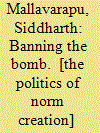

|
|
|
|
|
| Publication |
New Delhi, Pearson, 2007.
|
| Description |
xv, 229p.
|
| Standard Number |
97881131701171, hbk
|
|
|
|
|
|
|
|
|
|
|
|
Copies: C:1/I:0,R:0,Q:0
Circulation
| Accession# | Call# | Current Location | Status | Policy | Location |
| 056330 | 327.174/MAL 056330 | Main | On Shelf | General | |
|
|
|
|
| 8 |
ID:
095975
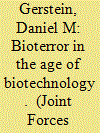

|
|
|
| 9 |
ID:
152192
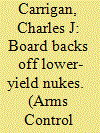

|
|
|
| 10 |
ID:
132165
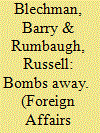

|
|
|
|
|
| Publication |
2014.
|
| Summary/Abstract |
In 1991, U.S. President George H. W. Bush decided to retire almost all the tactical nuclear weapons operated by the U.S. Army and the U.S. Navy. His reasons were simple: these short-range weapons were militarily useless and imposed significant burdens on the armed forces in terms of money, manpower, and time. Twenty-three years later, only one type of tactical nuclear weapon remains in the U.S. inventory: the B-61 gravity bomb. In addition to the several hundred B-61s located at home, the United States currently deploys around 180 of them in Europe, at bases in Belgium, Germany, Italy, the Netherlands, and Turkey. In the event of a nuclear conflict on the continent, NATO would deliver the bombs via U.S.-built F-15 or F-16 aircraft or European-built Tornado fighters, operated by some combination of Belgian, Dutch, German, Italian, and U.S. crews. Originally intended to prevent Soviet forces from penetrating Western Europe, the planes could travel as far east as Russia. But owing to their slower speed and lower altitude, they would be much more vulnerable to Russia's ground-based air defenses than would longer-range strategic bombers and missiles.
|
|
|
|
|
|
|
|
|
|
|
|
|
|
|
|
| 11 |
ID:
119035
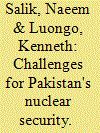

|
|
|
| 12 |
ID:
146545
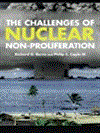

|
|
|
|
|
| Publication |
Lanham, Rowman and Littlefield, 2015.
|
| Description |
xvi, 238p.pbk
|
| Series |
Weapons of Mass Destruction Series; 2
|
| Standard Number |
9781442223752
|
|
|
|
|
|
|
|
|
|
|
|
Copies: C:1/I:0,R:0,Q:0
Circulation
| Accession# | Call# | Current Location | Status | Policy | Location |
| 058759 | 327.1747/BUR 058759 | Main | On Shelf | General | |
|
|
|
|
| 13 |
ID:
170818
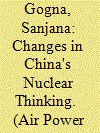

|
|
|
| 14 |
ID:
101555
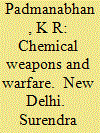

|
|
|
|
|
| Publication |
New Delhi, Surendra Publications, 2010.
|
| Description |
246p.
|
| Standard Number |
9789380014500, hbk
|
|
|
|
|
|
|
|
|
|
|
|
Copies: C:1/I:0,R:0,Q:0
Circulation
| Accession# | Call# | Current Location | Status | Policy | Location |
| 055597 | 358.34/PAD 055597 | Main | On Shelf | General | |
|
|
|
|
| 15 |
ID:
098238
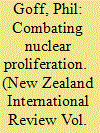

|
|
|
| 16 |
ID:
139044
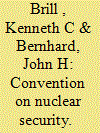

|
|
|
|
|
| Summary/Abstract |
In his 2009 speech in Prague, President Barack Obama declared, “[W]e must ensure that terrorists never acquire a nuclear weapon. This is the most immediate and extreme threat to global security.” To help deal with this threat, he said the world needed “durable institutions” devoted to the problem and announced that the United States would host a global summit on nuclear security in part to address that issue
|
|
|
|
|
|
|
|
|
|
|
|
|
|
|
|
| 17 |
ID:
100251
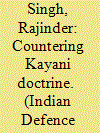

|
|
|
| 18 |
ID:
133071
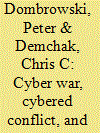

|
|
|
|
|
| Publication |
2014.
|
| Summary/Abstract |
It has been well over a decade since the first “prophets” of information warfare proclaimed a new age of conflict fought not just on air, sea, and land but with electrons in what came to be known as “cyberspace.”1 Since these early predictions, many incidents have confirmed that criminals, random hackers, and government-sanctioned specialists can wreak havoc on governments, military communications systems, and corporations. The Stuxnet worm alone helped delay-by months, perhaps years-the long-standing efforts of Iran to acquire sufficient nuclear material to build nuclear weapons.2 Recent revelations of hacking campaigns against such publications as the Wall Street Journal and New York Times have broadened concerns to include even the integrity of American democratic institutions.3 Meanwhile, the commander of U.S. Cyber Command has characterized cyber attacks designed to gain access to the intellectual property of American corporations as the “greatest transfer of wealth in human history.”
|
|
|
|
|
|
|
|
|
|
|
|
|
|
|
|
| 19 |
ID:
115804
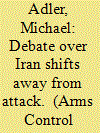

|
|
|
| 20 |
ID:
111046
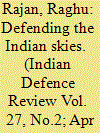

|
|
|
|
|
|
|
|